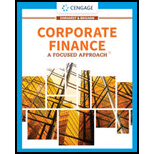
a)
To determine: The definition of liquidity ratios.
a)
Explanation of Solution
A liquidity proportion may be a proportion that appears the link of a company's money and current resources to the current liabilities. The current proportion is determined by:
It shows the degree to which CL's are secured by these assets supposed to be changed over to money within the close future. The quick, or acid test, ratio is determined using below formula:
b)
To determine: The definitions of asset management ratios.
b)
Explanation of Solution
It is a collection of proportions that degree how viably a company is overseeing its assets. The stock turnover proportion is:
DSO is utilized to assess accounts receivable and shows the length of time the firm must hold up after making a deal some time recently accepting cash. DSO is determined by:
The FA turnover proportion estimates how viably the company employments its plant and machinery and hardware. It is the proportion of deals to net FA. Overall asset turnover proportion computes the turnover of all the company’s resources; it is ascertained using below equation:
c)
To determine: The definitions of financial leverage ratios.
c)
Explanation of Solution
Financial leverage proportions degree the utilize of financing by way of debt. The debt proportion is the proportion of total debt, which more often than not is the entirety of notes payable and long-term bonds, to add up to resources, it estimates the rate of resources funded by debtholders. The debt-to-equity proportion is the overall debt by the overall common equity. The times-interest-earned proportion is decided by isolating EBIT by the intrigued charges. This proportion estimates the degree to which the working salary can decrease sometime recently the business is incapable to reach its yearly intrigued costs. The EBITDA scope proportion is related to the TIE proportion, but it realizes that numerous company's rent resources conjointly must make sinking finance installments. It is found by including EBITDA and rent installments at that point separating this add up to by intrigued charges, rent installments, and sinking finance installments over one short the assessed rate.
d)
To determine: The definitions of profitability ratios.
d)
Explanation of Solution
Profitability proportions are a set of proportions, that appear the mixed impacts of liquidity, resource administration, and obligation on processes. The benefit edge on deals, estimated by separating net pay by deals, gives the benefit per dollar of deals. Fundamental winning control is calculated by separating EBIT by add up to resources. This proportion appears the crude gaining control of the firm’s resources, sometime recently the impact of charges and use. Return on add up to resources is the proportion of net pay to overall assets. Return on common value is obtained by isolating net wages by common equity.
e)
To determine: The definitions of market value ratios.
e)
Explanation of Solution
market value proportions link to the company’s stock cost to its profit and book esteem per stock. The P/E proportion is determined by isolating cost per stock by profit per stock--this appears the amount that speculators are responsible to give per dollar of detailed benefits. The price/free cash stream is estimated by partitioning cost per stock by
f)
To determine: The definitions of trend analysis, comparative ratio analysis, and bench marking.
f)
Explanation of Solution
Trend investigation is an investigation of a company's money related proportions over time. It is utilized to assess the probability of enhancement or disintegration in its budgetary circumstance. A comparative proportion examination is when a company relates its proportions to other driving firms within a similar industry. This method is additionally called as benchmarking.
g)
To determine: The definitions of DuPont equation, window dressing, an d seasonal effects on ratios.
g)
Explanation of Solution
The DuPont condition may be an equation, which appears that the percentage of return on resources can be obtained as the product of the benefit edge times the overall resources turnover. Window dressing could be a strategy utilized by the companies to form their budgetary financial monetary money related budgetary explanations see superior to they truly are. Regular components can misshape proportion examination. At specific circumstances of the year, a business may have intemperate inventories in the planning of a “season” of tall request. Subsequently, a stock turnover proportion taken at this time as restricted to after the season will be drastically distorted.
Want to see more full solutions like this?
Chapter 3 Solutions
CORPORATE FINANCE (LOOSELEAF)-TEXT
 Cornerstones of Financial AccountingAccountingISBN:9781337690881Author:Jay Rich, Jeff JonesPublisher:Cengage Learning
Cornerstones of Financial AccountingAccountingISBN:9781337690881Author:Jay Rich, Jeff JonesPublisher:Cengage Learning
 College Accounting, Chapters 1-27AccountingISBN:9781337794756Author:HEINTZ, James A.Publisher:Cengage Learning,
College Accounting, Chapters 1-27AccountingISBN:9781337794756Author:HEINTZ, James A.Publisher:Cengage Learning, Survey of Accounting (Accounting I)AccountingISBN:9781305961883Author:Carl WarrenPublisher:Cengage Learning
Survey of Accounting (Accounting I)AccountingISBN:9781305961883Author:Carl WarrenPublisher:Cengage Learning



